Ultramorphology and Molecular Studies of Contracaecum Larvae (Nematoda: Anisakidae) Collected in Five Cyprinid Fish Species from Sulaimani Province, Kurdistan Region-Iraq
- PMID: 33664617
- PMCID: PMC7912228
- DOI: 10.2478/helm-2021-0001
Ultramorphology and Molecular Studies of Contracaecum Larvae (Nematoda: Anisakidae) Collected in Five Cyprinid Fish Species from Sulaimani Province, Kurdistan Region-Iraq
Abstract
A total of 1134 freshwater fishes belonging to Cyprinidae (Acanthobrama marmid (n=20), Alburnus caeruleus (n=7), Alburnus mossulensis (n=62), Arabibarbus grypus (n=123), Barbus lacerta (n=7), Capoeta trutta (n=222), C. umbla (n=161), Carasobarbus kosswigi (n=5), C. luteus (n=89), Carassius auratus (n=54), Chondrostoma regium (n=52), Cyprinion kais (n=10) and C. macrostomum (n=322)) were collected in different water bodies in Sulaimani Province, Kurdistan Region-Iraq for the presence of larval nematode of the genus Conteacaecum. This investigation revealed that 17 fishes belonged to five species (A. marmid, A. grypus, C. trutta, C. luteus and C. regium) were infected with Contracaecum larvae with prevalence of 35 %, 0.81 %, 0.90 %, 4.49 % and 5.76 %, respectively. The third- larval stage was morphologically studied by optical microscopy, and the ultrastructure was investigated using scanning electron microscopy (SEM). In addition, molecular analysis was carried out by amplifying, sequencing and comparing different gene loci, including internal transcribed spacers (ITS-1 and ITS-2) and cytochrome oxidase c subunit-II (COX-2), of the different isolated Contracaecum larvae. These sequences were also compared with closely related nematode sequences from the GenBank. Fifteen sequences were obtained for this study from the collected Contracaecum larvae. ITS-1, ITS-2 and COX-2 were amplified by polymerase chain reaction (PCR) and sequenced. The sequences of ITS-1, ITS-2 and COX-2 revealed that the collected Contracaecum larval specimens from all infected fish species represented one species (Contracaecum rudolphii B) based on the identity percentage in the GenBank database. The genetic characterisation of the parasite in the present study is available in the GenBank database, and the obtained ITS-1, ITS-2 and COX-2 sequences were deposited in GenBank. The present study provides information on the accurate identification and molecular analysis of Contracaecum larvae in the infected fish species in Sulaimani Province, Kurdistan Region-Iraq.
Keywords: Contracaecum rudolphii B; Cyprinidae; Genetics; Nematode; Systematics.
© 2021 Y. S. Abdullah, S. M. A. Abdullah, R. H. Hussein, published by Sciendo.
Conflict of interest statement
Conflict of Interest The authors declare that they have no conflict of interest.
Figures
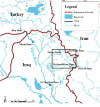
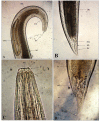

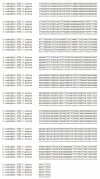
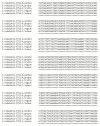


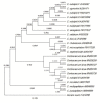

Similar articles
-
Molecular identification and larval morphological description of Contracaecum pelagicum (Nematoda: Anisakidae) from the anchovy Engraulis anchoita (Engraulidae) and fish-eating birds from the Argentine North Patagonian Sea.Parasitol Int. 2013 Jun;62(3):309-19. doi: 10.1016/j.parint.2013.03.001. Epub 2013 Mar 14. Parasitol Int. 2013. PMID: 23500719
-
Genetic identification and insights into the ecology of Contracaecum rudolphii A and C. rudolphii B (Nematoda: Anisakidae) from cormorants and fish of aquatic ecosystems of Central Italy.Parasitol Res. 2020 Apr;119(4):1243-1257. doi: 10.1007/s00436-020-06658-8. Epub 2020 Apr 2. Parasitol Res. 2020. PMID: 32239289
-
Molecular identification of two strains of third-stage larvae of Contracaecum rudolphii sensu lato (Nematoda: Anisakidae) from fish in Poland.J Parasitol. 2007 Aug;93(4):961-4. doi: 10.1645/GE-1100R.1. J Parasitol. 2007. PMID: 17918390
-
Mutation scanning-coupled sequencing of nuclear ribosomal DNA spacers as a tool for the specific identification of different Contracaecum (Nematoda: Anisakidae) larval types.Mol Cell Probes. 2011 Feb;25(1):13-8. doi: 10.1016/j.mcp.2010.09.003. Epub 2010 Oct 8. Mol Cell Probes. 2011. PMID: 20933594
-
[The possibility of completing the life cycle of Hysterothylacium aduncum (Rudolphi, 1802) and Contracaecum rudolphii (Hartwich, 1964) (Nematoda) at the waters of Vistula Lagoon].Wiad Parazytol. 2005;51(3):239-41. Wiad Parazytol. 2005. PMID: 16913529 Review. Polish.
Cited by
-
Invasion dynamics and ecological impacts of Anisakis typica in commercial fish from the Western Pacific Ocean.Vet World. 2025 May;18(5):1365-1376. doi: 10.14202/vetworld.2025.1365-1376. Epub 2025 May 31. Vet World. 2025. PMID: 40584111 Free PMC article.
References
-
- Abdullah S.M.A., Rasheed A.A.. Parasitic fauna of some freshwater fishes from Dokan lake, north of Iraq, II: Endoparasites. Ibn Al-Haitham J. Pure Appl. Sci. 2004;17(5):1–12.
-
- Abdullah S.M.A., Mhaisen F.T.. Infection of fishes from Greater Zab and Lesser Zab rivers in north of Iraq with larvae of nematode Contracaecum spp. Kirkuk Univ. J. Sci. Stud. 2011;6(3):694–701. (In Arabic)
-
- Al-Hadithi I.A.W., Abdullah B.H.. Some helminth parasites from three species of aquatic bird in Basrah, Iraq. Basrah J. Agric. Sci. 1991;4:261. –. (in Arabic)
-
- Ali N.M., Salih N.E., Abdul-Ameer K.N.. Parasitic fauna of some freshwater fishes from Tigris river, Baghdad, Iraq, IV: Nematoda. J. Biol. Sci. Res. 1987;18(3):35–45.
-
- Al-Moussawi A.A., Mohammad M.K.. Contracaecum rudolphii Hartwich, 1964 (Nematoda: Anisakidae) in the Cormorant Phalacrocorax carbo (Linnaeus, 1758) wintering in Baghdad area: A new host record in Iraq. Bull. Iraq nat. Hist. Mus. 2011;11(3):7–16.
LinkOut - more resources
Full Text Sources
Other Literature Sources
Research Materials
